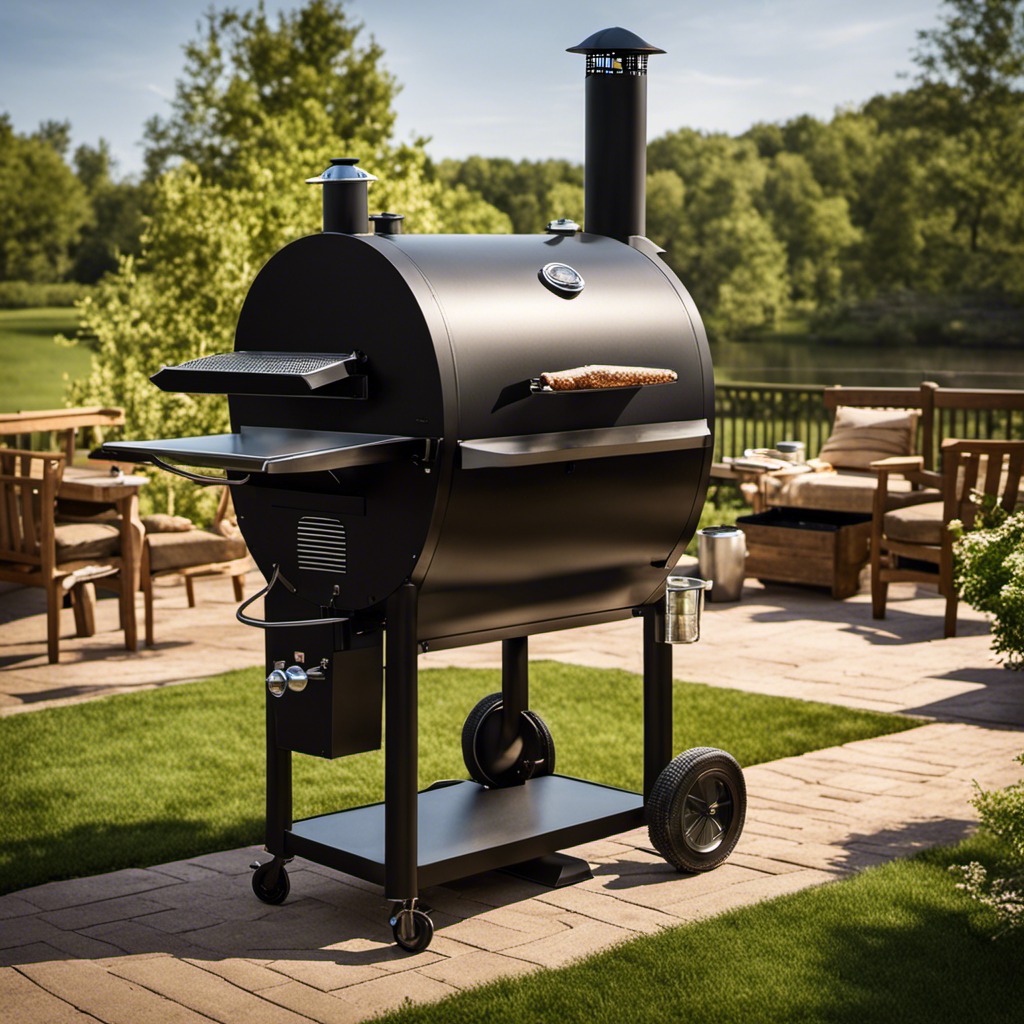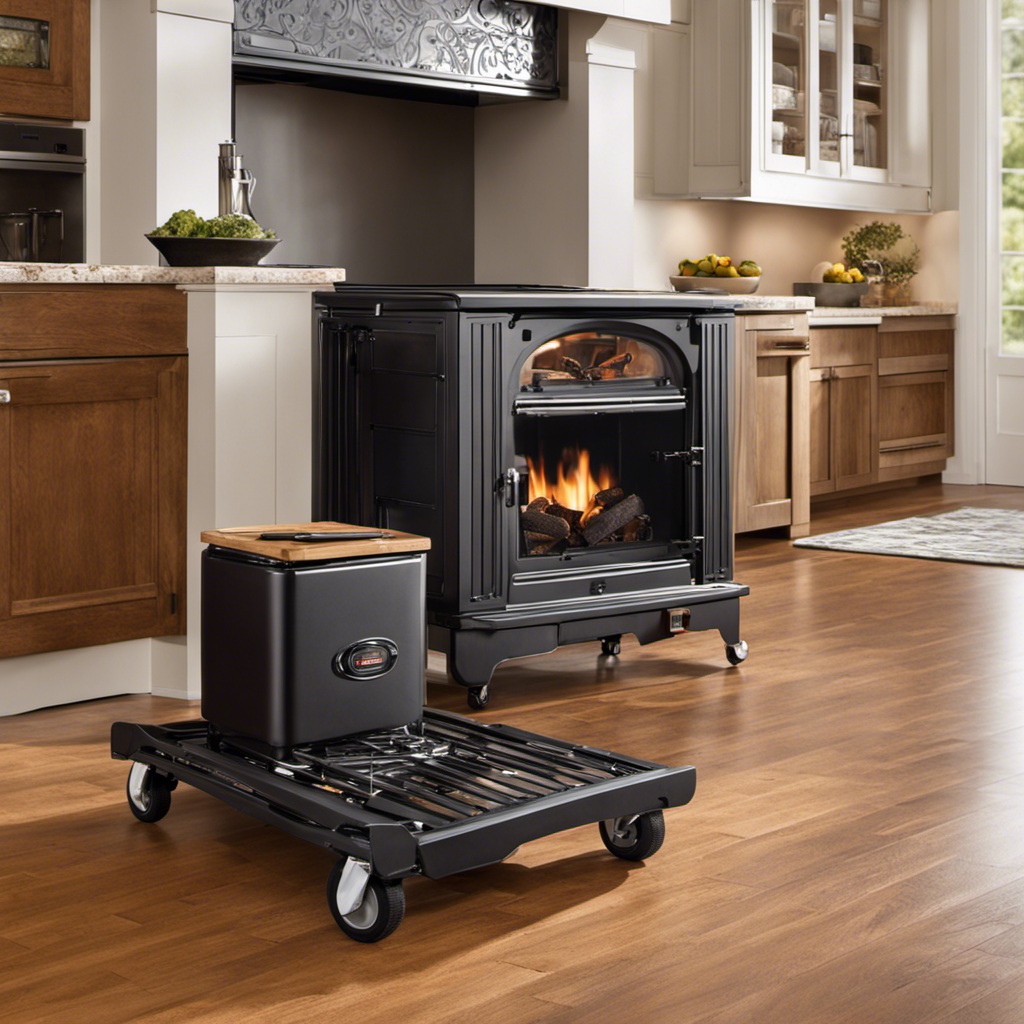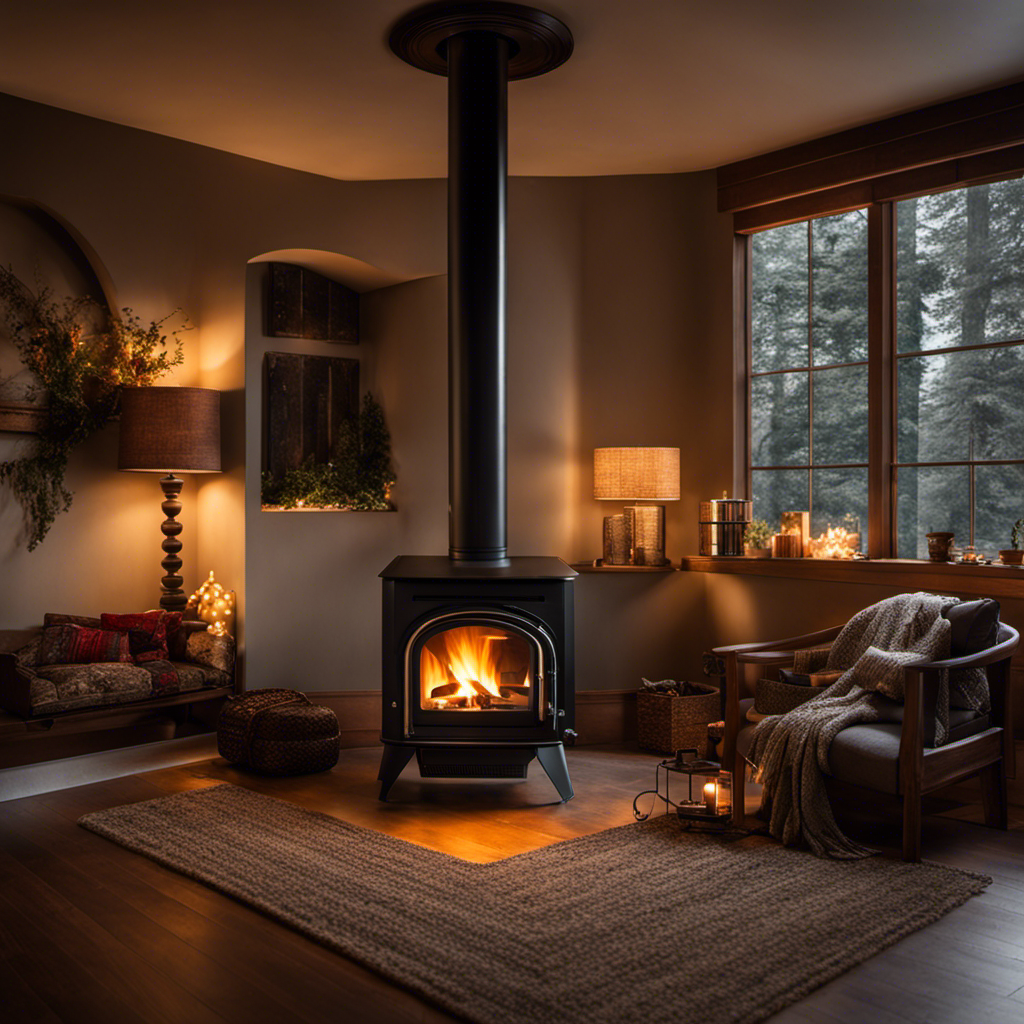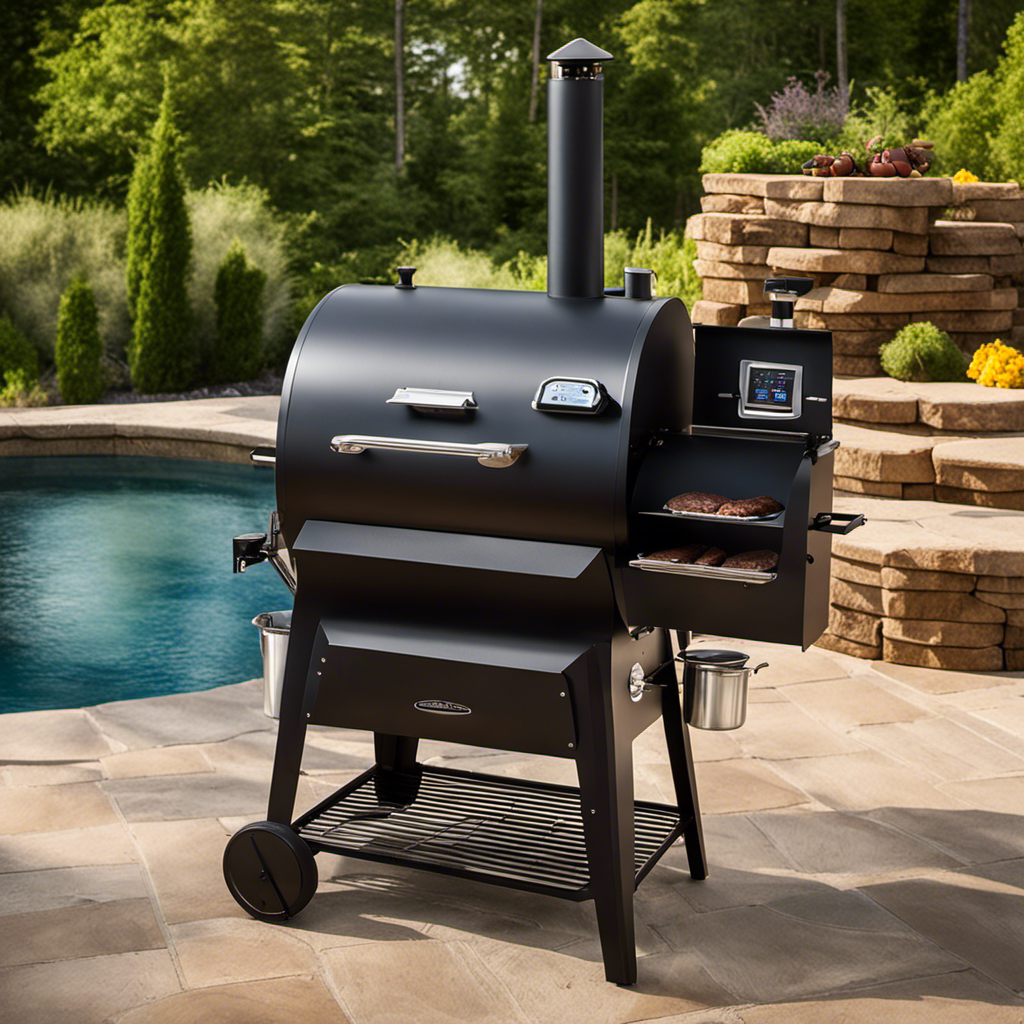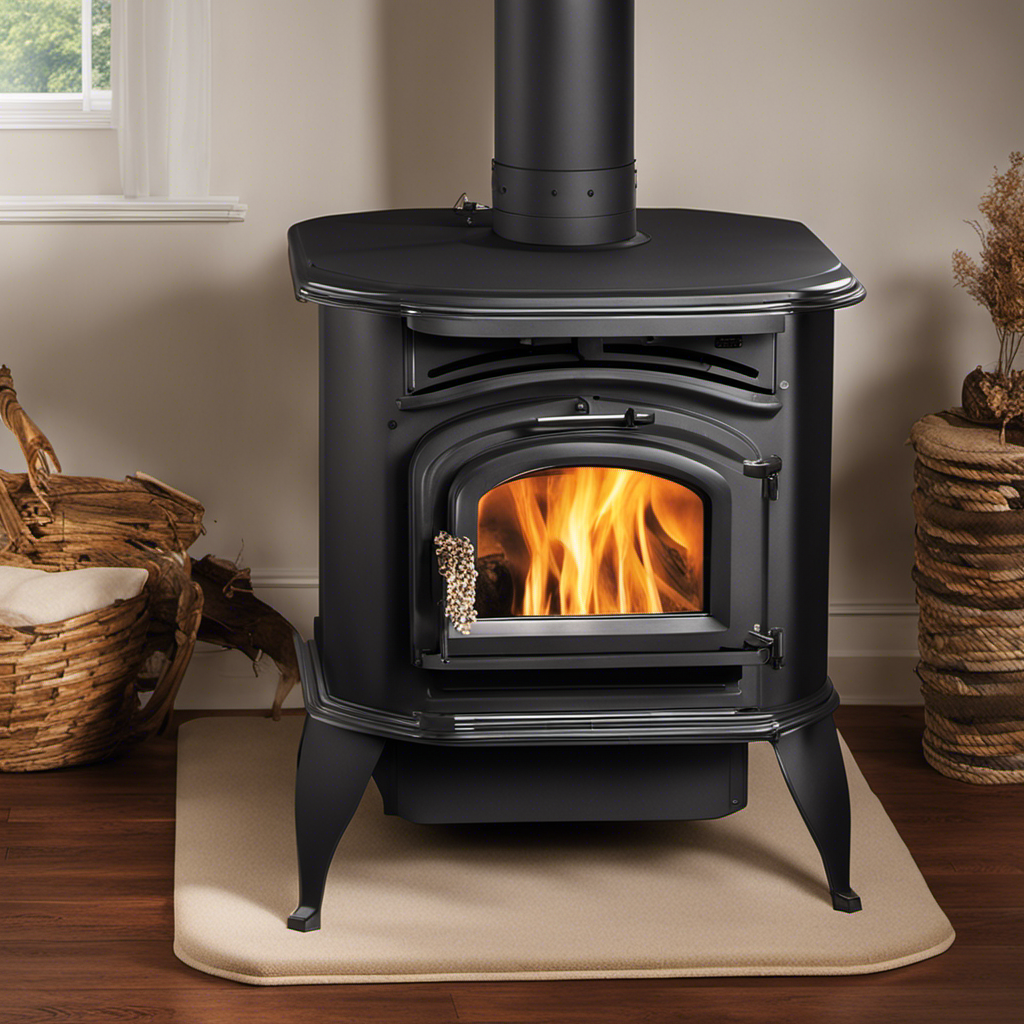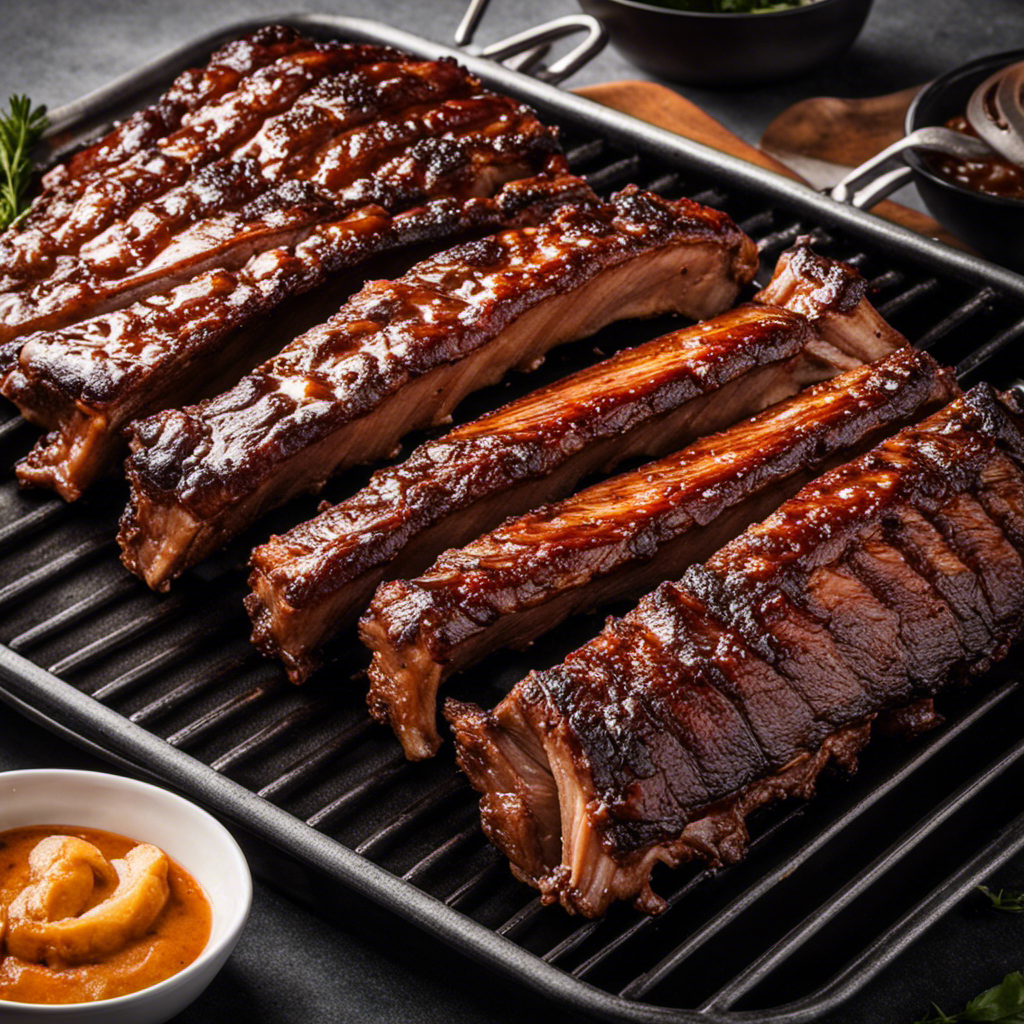I have a strong passion for barbecue and experimenting with various cooking styles. Recently, I’ve been intrigued by the concept of wood pellet grills. However, I am curious to learn more about how these grills work. What is their mechanism of operation?
In this article, we’ll delve into the fascinating world of wood fired pellet grills and uncover their inner workings. From the pellet hopper and auger system to the digital control panel, we’ll explore every aspect that makes these grills a must-have for any grill enthusiast.
So, let’s dive in and discover the magic behind wood fired pellet grills.
Key Takeaways
- Wood fired pellet grills use wood pellets as fuel, offering benefits over charcoal or gas grills.
- The pellet hopper stores wood pellets for fuel, and regular maintenance includes cleaning the hopper for optimal performance.
- The auger system transports pellets from the hopper to the fire pot, and issues with the auger may require troubleshooting and clearing obstructions.
- The digital control panel allows easy adjustment of temperature and cooking settings, offering various cooking modes and a timer function for hassle-free grilling and consistent results.
The Basics of Wood Fired Pellet Grills
To understand the basics of wood fired pellet grills, you’ll need to know how they work.
These grills use wood pellets as fuel, which offers several benefits over traditional charcoal or gas grills.
One of the main advantages is the ability to achieve consistent temperature control, thanks to the automated pellet feed system.
The different types of wood pellets available also contribute to the flavor profile of your food.
For example, hickory pellets give a smoky taste, while apple pellets add a sweet and fruity flavor.
Understanding how the pellet hopper and auger system function is crucial to operating a wood fired pellet grill effectively.
Understanding the Pellet Hopper and Auger System
Take a moment to understand how the pellet hopper and auger system in your grill function.
The pellet hopper is where you store the wood pellets that will be used as fuel for your grill. It is important to keep the hopper clean and free from any debris or moisture to ensure optimal performance. Regular pellet hopper maintenance includes emptying and cleaning it thoroughly.
Now, let’s move on to the auger system. The auger is responsible for transporting the wood pellets from the hopper to the fire pot. If you encounter any issues with the pellet auger, such as jams or blockages, troubleshooting may be required. This can involve clearing any obstructions and ensuring that the auger is properly aligned.
Understanding the pellet hopper and auger system is essential for the smooth operation of your wood-fired pellet grill.
Now, let’s explore the role of the digital control panel and how it enhances your grilling experience.
The Role of the Digital Control Panel
Using the digital control panel, you can easily adjust the temperature and cooking settings of your grill. This advanced feature is designed to provide convenience and precision in your grilling experience.
The digital control panel allows you to set and monitor the temperature of the grill with just a few button presses. It also offers various cooking modes, such as smoke, grill, bake, and roast, giving you the flexibility to cook a wide range of dishes. Additionally, the digital control panel often includes a timer function, allowing you to set the cooking time and receive notifications when your food is ready.
With its user-friendly interface and intuitive controls, the digital control panel makes grilling hassle-free and ensures consistent and delicious results every time.
Transitioning to the subsequent section on the ignition and startup process, let’s explore how easily you can get your wood fired pellet grill up and running.
Ignition and Startup Process
Let’s explore how you can easily get your grill up and running with the ignition and startup process.
When it comes to the ignition process of a wood-fired pellet grill, there are a few key tips to keep in mind. First, ensure that the pellet hopper is filled with the appropriate amount of wood pellets. Next, turn the grill’s power switch to the ‘on’ position. Once the grill is powered on, set the temperature to your desired cooking level using the digital control panel. After setting the temperature, press the ignition button to start the fire in the grill.
It’s important to allow the grill to preheat for about 10-15 minutes before placing any food on the cooking grates. This preheating time ensures that the grill reaches the desired temperature and is ready for cooking.
Now that we have covered the ignition and startup process, let’s move on to the importance of temperature control in wood-fired pellet grills.
The Importance of Temperature Control
To ensure your food is cooked to perfection, it’s important to properly control the temperature of your grill. Temperature accuracy is crucial when it comes to achieving the desired results, especially when using smoking techniques.
When using a wood fired pellet grill, maintaining the correct temperature is key to achieving the ideal smoky flavor and tender texture. These grills are designed to provide precise temperature control, allowing you to set the desired temperature and maintain it throughout the cooking process. This level of control ensures that your food is cooked evenly and to your liking.
Now, let’s delve into how wood pellets create heat and smoke, further enhancing the flavor of your dishes.
How Wood Pellets Create Heat and Smoke
Maintaining the correct temperature is essential for achieving the ideal smoky flavor and tender texture when cooking with wood pellets in a grill. Wood pellets create heat and smoke through a process called wood pellet combustion.
When the wood pellets are ignited, they undergo combustion, releasing heat and gases that produce smoke. The combustion process is controlled by the grill’s temperature settings and airflow adjustments.
The benefits of using wood pellets for combustion include their high energy density, which allows them to burn efficiently and produce consistent heat. Additionally, wood pellets are made from compressed sawdust and other wood byproducts, making them a sustainable and renewable fuel source.
With wood pellets, you can enjoy the authentic smoky flavor and reliable heat for your grilling needs.
Now, let’s explore the cooking grates and heat distribution in a wood pellet grill.
Exploring the Cooking Grates and Heat Distribution
When it comes to grilling, the choice of grill grate material is crucial in achieving the desired cooking results. Different materials, such as stainless steel, cast iron, and porcelain-coated steel, have varying heat retention and distribution properties.
Ensuring even heat distribution across the cooking surface is essential for cooking food evenly and preventing hotspots.
Furthermore, the choice of grill grate material can also impact cooking efficiency, affecting factors such as searing ability and heat retention.
Grill Grate Material
Did you know that one important aspect to consider when choosing a wood fired pellet grill is the material of the grill grate? The grill grate plays a crucial role in the cooking process, as it directly comes in contact with the food and affects its flavor and texture. There are different materials available for grill grates, each with its own pros and cons. Let’s take a look at a comparison table of three common grill grate materials:
| Material | Maintenance | Heat Retention |
|---|---|---|
| Cast Iron | Requires regular seasoning with oil to prevent rust. | Excellent heat retention, which allows for even cooking. |
| Stainless Steel | Easy to clean and maintain. | Average heat retention, may lead to uneven cooking. |
| Porcelain-Coated | Requires gentle cleaning to prevent chipping. | Good heat retention, but may chip over time. |
Now that we have explored the grill grate materials, let’s move on to the next section about even heat distribution.
Even Heat Distribution
To achieve even heat distribution, it’s important to understand how the grill’s heat source is positioned. In wood fired pellet grills, the heat source is typically located at the bottom of the grill, beneath the grill grates. This positioning allows for consistent heat to rise evenly and surround the food being cooked.
The pellets are ignited by an electric igniter, creating a steady flame that heats the grill chamber. The temperature control in pellet grills is achieved by adjusting the rate at which the pellets are fed into the firepot. By increasing or decreasing the pellet feed, you can raise or lower the temperature inside the grill.
This precise temperature control ensures that the heat is distributed evenly throughout the cooking process, resulting in perfectly cooked and flavorful food.
Speaking of cooking efficiency…
Cooking Efficiency
Achieving even heat distribution is crucial for cooking efficiency and ensuring that your food is perfectly cooked and flavorful. Wood fired pellet grills utilize advanced technology to achieve this goal. Here are four key factors that contribute to their cooking efficiency:
-
Intelligent Temperature Control: Wood fired pellet grills are equipped with smart temperature controllers that maintain a consistent cooking temperature throughout the grilling process. This ensures that your food is cooked evenly and avoids any hot or cold spots.
-
Direct and Indirect Cooking Techniques: These grills offer the flexibility to cook using both direct and indirect heat methods. Direct heat is perfect for searing meat, while indirect heat is ideal for slow cooking. This versatility allows you to experiment with different cooking techniques and achieve optimal results.
-
Efficient Fuel Consumption: Wood pellets are the fuel source for these grills, and they burn efficiently, resulting in minimal waste. The grills are designed to use just the right amount of pellets needed for each cooking session, ensuring that the fuel is utilized effectively.
-
Convection Cooking: Wood fired pellet grills utilize convection cooking, which circulates the heat evenly around the food. This method helps to cook the food faster and more evenly, reducing the cooking time while maintaining the desired level of doneness.
By understanding these cooking techniques and maximizing fuel consumption, wood fired pellet grills offer an efficient way to cook delicious meals with ease.
Now, let’s move on to cleaning and maintenance tips for these grills.
Cleaning and Maintenance Tips for Wood Fired Pellet Grills
When it comes to cleaning and maintaining wood-fired pellet grills, I have found a few key techniques and tips to be essential.
Firstly, I always start by brushing the cooking grates thoroughly to remove any food residue or debris.
Next, I make sure to clean the burn pot and remove any ash buildup. This is important to ensure proper heat distribution and prevent any potential blockages.
Lastly, I regularly inspect and clean the interior and exterior of the grill. This includes the grease tray and drip pan. Keeping these areas clean helps to keep the grill in optimal working condition.
Overall, following these steps will help you maintain a clean and well-functioning wood-fired pellet grill.
Cleaning Techniques for Grills
Cleaning grills is essential for maintaining their performance and extending their lifespan. Proper grill maintenance ensures that it functions efficiently and produces delicious, evenly cooked food.
To keep your grill in top shape, here are some cleaning techniques to consider:
-
Regularly remove grease and residue: Grease buildup can affect the flavor of your food and increase the risk of flare-ups. Use a wire brush or grill scraper to remove any stuck-on grease and residue from the grates.
-
Clean the burners and heat deflectors: Over time, burners and heat deflectors can become clogged with debris, affecting the grill’s performance. Remove them and clean them thoroughly with warm, soapy water.
-
Wipe down the exterior: Don’t forget to clean the outside of your grill as well. Use a mild detergent and a soft cloth to remove any dirt or grime.
By following these cleaning techniques, you can ensure that your grill remains in optimal condition and ready for your next cookout.
Now, let’s move on to some essential maintenance tips to keep your grill running smoothly.
Essential Maintenance Tips
To ensure optimal performance and longevity of your grill, it’s important to regularly inspect and replace any worn-out or damaged parts.
Proper grill maintenance is key to keeping your grill in top shape and avoiding any potential issues. Start by cleaning the grill thoroughly after each use, removing any residue or grease buildup.
Check the burners and igniters for any signs of wear or damage and replace them if necessary. Inspect the gas lines for leaks and ensure they are properly connected.
Additionally, regularly clean and maintain the grill grates, as they can become clogged with food debris over time. By following these grill maintenance and troubleshooting tips, you can ensure that your grill will continue to perform at its best.
Now, let’s move on to enhancing flavor with wood pellet selection.
Enhancing Flavor With Wood Pellet Selection
You can enhance the flavor of your food by selecting different types of wood pellets for your wood-fired pellet grill. The type of wood you choose will impart unique flavors to your dishes, creating a smoky and delicious taste.
Here are three popular wood pellet flavors and their corresponding cooking techniques:
-
Mesquite: This strong and robust wood pellet is perfect for grilling and smoking meats. It pairs well with beef and pork, providing a bold and intense flavor profile.
-
Apple: If you’re looking for a milder and sweeter taste, apple wood pellets are a great choice. They are ideal for smoking poultry, fish, and vegetables, adding a subtle fruity aroma to your dishes.
-
Hickory: Known for its rich and smoky flavor, hickory wood pellets are versatile and can be used for smoking a variety of meats, such as ribs, brisket, and chicken. They add a distinct and savory taste to your food.
Experiment with different wood pellet flavors to elevate your cooking and create unique and delicious dishes on your wood-fired pellet grill.
Can I use wood fired pellet grills to grill pork chops?
Yes, you can use wood fired pellet grills for grilling pork chops on pit boss. The natural wood flavor enhances the taste of the pork chops, making them delicious and juicy. The consistent temperature control of the grill ensures that the pork chops are cooked to perfection every time.
Can I Use a Wood Fired Pellet Grill to Grill Pork Chops?
Yes, you can definitely enjoy grilling pork chops on a wood pellet grill. The smoky, rich flavor from the wood adds an extra layer of deliciousness to the pork chops. The consistent temperature control of a pellet grill ensures that your pork chops are perfectly cooked every time. Try it out!
Frequently Asked Questions
Can Wood Fired Pellet Grills Be Used for Both Grilling and Smoking?
Yes, wood fired pellet grills can be used for both grilling and smoking. To achieve the perfect smoke flavor, adjust the temperature and use wood pellets specifically designed for smoking.
Are Wood Pellets the Only Fuel Source That Can Be Used in a Wood Fired Pellet Grill?
Yes, wood pellets are the most commonly used fuel source for wood fired pellet grills. However, there are alternative fuel sources such as charcoal and wood chips. Wood pellets offer advantages like consistent heat and clean combustion.
How Long Does It Typically Take for a Wood Fired Pellet Grill to Reach the Desired Temperature?
It usually takes around 10-15 minutes for a wood fired pellet grill to reach the desired temperature. The advantage of using a wood fired pellet grill over traditional charcoal grills is the convenience it offers.
Can Wood Fired Pellet Grills Be Used in All Weather Conditions?
Yes, wood fired pellet grills can be used in all weather conditions. The advantage of using wood pellets is their ability to burn efficiently and consistently, providing consistent heat and smoke flavor.
Is It Necessary to Clean the Pellet Hopper and Auger System Regularly?
Yes, it is necessary to clean the pellet hopper and auger system regularly to ensure proper functioning of the wood fired pellet grill. Cleaning requirements and maintenance tips should be followed as per the manufacturer’s instructions.
Conclusion
In conclusion, after investigating the inner workings of wood-fired pellet grills, it is clear that these innovative devices offer a seamless cooking experience.
The pellet hopper and auger system efficiently deliver wood pellets to create heat and smoke, while the digital control panel allows for precise temperature control.
The ignition and startup process ensures a quick and easy start, while the cooking grates and heat distribution ensure even cooking.
By selecting the right wood pellets, you can enhance the flavor of your dishes.
With proper cleaning and maintenance, you can enjoy the benefits of a wood-fired pellet grill for years to come.
Growing up surrounded by the vast beauty of nature, Sierra was always drawn to the call of the wild. While others sought the comfort of the familiar, she ventured out, embracing the unpredictable and finding stories in the heartbeat of nature.
At the epicenter of every remarkable venture lies a dynamic team—a fusion of diverse talents, visions, and passions. The essence of Best Small Wood Stoves is crafted and refined by such a trio: Sierra, Logan, and Terra. Their collective expertise has transformed the platform into a leading authority on small wood stoves, radiating warmth and knowledge in equal measure.

